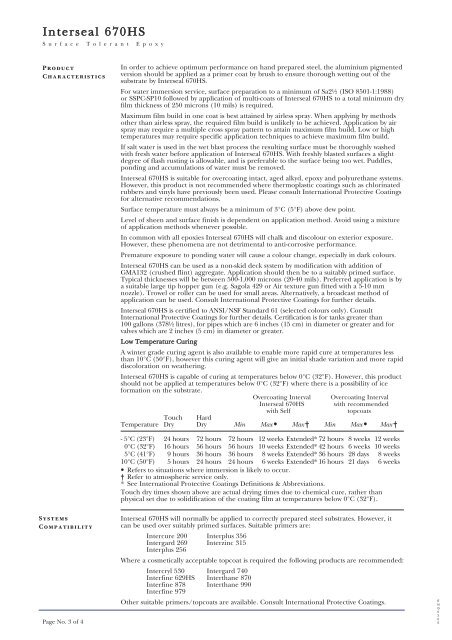English (United Kingdom) - Paul Wurth
English (United Kingdom) - Paul Wurth
English (United Kingdom) - Paul Wurth
- TAGS
- wurth
- www.paulwurth.com
Create successful ePaper yourself
Turn your PDF publications into a flip-book with our unique Google optimized e-Paper software.
Interseal 670HS<br />
S u r f a c e T o l e r a n t E p o x y<br />
Product<br />
Characteristics<br />
Systems<br />
Compatibility<br />
Page No. 3 of 4<br />
In order to achieve optimum performance on hand prepared steel, the aluminium pigmented<br />
version should be applied as a primer coat by brush to ensure thorough wetting out of the<br />
substrate by Interseal 670HS.<br />
For water immersion service, surface preparation to a minimum of Sa2½ (ISO 8501-1:1988)<br />
or SSPC-SP10 followed by application of multi-coats of Interseal 670HS to a total minimum dry<br />
film thickness of 250 microns (10 mils) is required.<br />
Maximum film build in one coat is best attained by airless spray. When applying by methods<br />
other than airless spray, the required film build is unlikely to be achieved. Application by air<br />
spray may require a multiple cross spray pattern to attain maximum film build. Low or high<br />
temperatures may require specific application techniques to achieve maximum film build.<br />
If salt water is used in the wet blast process the resulting surface must be thoroughly washed<br />
with fresh water before application of Interseal 670HS. With freshly blasted surfaces a slight<br />
degree of flash rusting is allowable, and is preferable to the surface being too wet. Puddles,<br />
ponding and accumulations of water must be removed.<br />
Interseal 670HS is suitable for overcoating intact, aged alkyd, epoxy and polyurethane systems.<br />
However, this product is not recommended where thermoplastic coatings such as chlorinated<br />
rubbers and vinyls have previously been used. Please consult International Protective Coatings<br />
for alternative recommendations.<br />
Surface temperature must always be a minimum of 3°C (5°F) above dew point.<br />
Level of sheen and surface finish is dependent on application method. Avoid using a mixture<br />
of application methods whenever possible.<br />
In common with all epoxies Interseal 670HS will chalk and discolour on exterior exposure.<br />
However, these phenomena are not detrimental to anti-corrosive performance.<br />
Premature exposure to ponding water will cause a colour change, especially in dark colours.<br />
Interseal 670HS can be used as a non-skid deck system by modification with addition of<br />
GMA132 (crushed flint) aggregate. Application should then be to a suitably primed surface.<br />
Typical thicknesses will be between 500-1,000 microns (20-40 mils). Preferred application is by<br />
a suitable large tip hopper gun (e.g. Sagola 429 or Air texture gun fitted with a 5-10 mm<br />
nozzle). Trowel or roller can be used for small areas. Alternatively, a broadcast method of<br />
application can be used. Consult International Protective Coatings for further details.<br />
Interseal 670HS is certified to ANSI/NSF Standard 61 (selected colours only). Consult<br />
International Protective Coatings for further details. Certification is for tanks greater than<br />
100 gallons (378½ litres), for pipes which are 6 inches (15 cm) in diameter or greater and for<br />
valves which are 2 inches (5 cm) in diameter or greater.<br />
Low Temperature Curing<br />
A winter grade curing agent is also available to enable more rapid cure at temperatures less<br />
than 10°C (50°F), however this curing agent will give an initial shade variation and more rapid<br />
discoloration on weathering.<br />
Interseal 670HS is capable of curing at temperatures below 0°C (32°F). However, this product<br />
should not be applied at temperatures below 0°C (32°F) where there is a possibility of ice<br />
formation on the substrate.<br />
Overcoating Interval Overcoating Interval<br />
Interseal 670HS with recommended<br />
with Self topcoats<br />
Touch Hard<br />
Temperature Dry Dry Min Max • Max † Min Max • Max †<br />
- 5°C (23°F) 24 hours 72 hours 72 hours 12 weeks Extended* 72 hours 8 weeks 12 weeks<br />
0°C (32°F) 16 hours 56 hours 56 hours 10 weeks Extended* 42 hours 6 weeks 10 weeks<br />
5°C (41°F) 9 hours 36 hours 36 hours 8 weeks Extended* 36 hours 28 days 8 weeks<br />
10°C (50°F) 5 hours 24 hours 24 hours 6 weeks Extended* 16 hours 21 days 6 weeks<br />
• Refers to situations where immersion is likely to occur.<br />
† Refer to atmospheric service only.<br />
* See International Protective Coatings Definitions & Abbreviations.<br />
Touch dry times shown above are actual drying times due to chemical cure, rather than<br />
physical set due to solidification of the coating film at temperatures below 0°C (32°F).<br />
Interseal 670HS will normally be applied to correctly prepared steel substrates. However, it<br />
can be used over suitably primed surfaces. Suitable primers are:<br />
Intercure 200 Interplus 356<br />
Intergard 269 Interzinc 315<br />
Interplus 256<br />
Where a cosmetically acceptable topcoat is required the following products are recommended:<br />
Intercryl 530 Intergard 740<br />
Interfine 629HS Interthane 870<br />
Interfine 878 Interthane 990<br />
Interfine 979<br />
Other suitable primers/topcoats are available. Consult International Protective Coatings.<br />
E<br />
N<br />
G<br />
0<br />
3<br />
0<br />
5




